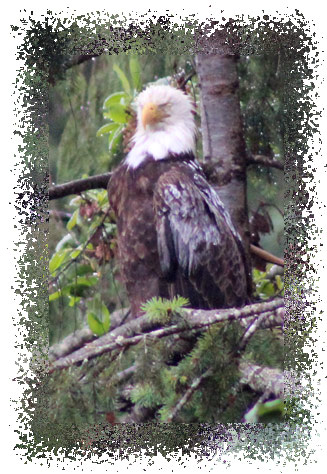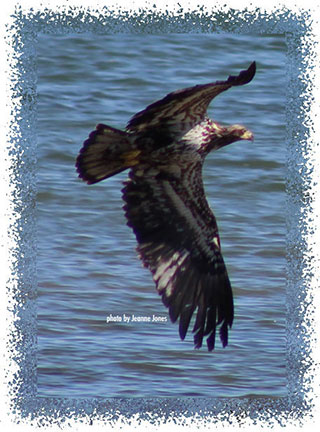

The Bald Eagle (Haliaeetus leucocephalus) received its name because of its white head, which appeared to be bald  from a distance. It was declared the national emblem of the United States of America in 1782. It is a large blackish-brown eagle with white head and tail and a large yellow bill.
from a distance. It was declared the national emblem of the United States of America in 1782. It is a large blackish-brown eagle with white head and tail and a large yellow bill.
Eagles soar with their wings held horizontal (vultures, with their wings slightly raised). Younger birds are dark-brown all over and resemble the adult Golden Eagle, but are variably marked with white and have a black, more massive bill. The Bald Eagle's neck is shorter and tail longer than the White-tailed Eagle; the Steller's Sea-Eagle has a longer, wedge-shaped tail. Bald Eagles require four or five years to reach full adult plumage. They are large birds (30-37") with a wingspan of from 6 feet to 7 feet, 6 inches. The female is larger, but is otherwise similar.
The Bald Eagle  is a permanent resident throughout its range, breeding from Alaska east to Newfoundland and south locally to California, the Great Lakes and Virginia; also in Arizona, along the Gulf Coast, and in Florida. It winters along coasts and large rivers in much of the United States.
is a permanent resident throughout its range, breeding from Alaska east to Newfoundland and south locally to California, the Great Lakes and Virginia; also in Arizona, along the Gulf Coast, and in Florida. It winters along coasts and large rivers in much of the United States.
It lays 2 or 3 white, unmarked ( 2.9 x 3.4") eggs in a large nest built of branches and sticks in treetops or cliffs; 30-90 feet up; in forested or wooded regions, near streams, lakes or ocean. Additions and repairs are made yearly. Both parents take turns incubating the eggs for about 35 days. The young stay in the nest for between 72 and 74 days. The voice is a harsh creaking cackling ("kark, kark") and thin squeals. Although the Bald Eagle eats carrion and sometimes catches crippled waterfowl, it is primarily a fish eater. They will also steal fish from Ospreys. In winter, birds and small mammals are more frequently taken.
Though not as common as in the past, impressive gatherings of these magnificent birds can still be seen in British Columbia and Alaska. There Bald Eagles come together to feed on the schools of salmon and herring swimming up the rivers to spawn. At such times between three thousand and four thousand have been counted in November on the Chilkat River in Alaska, where they feed on the dead and dying salmon.
Class: Aves | Order: Accipitriformes | Family: Accipitridae | Genus: Haliaeetus | Species: H. leucocephalus
This group of Bald Eagle plush toys can be found at Jeannie's cottage LLC. The large eagle at left is a Wild Republic Cuddlekins Bald Eagle. The one on the right is a Unipak Bald Eagle Backpack. There is a Ganz Heritage Collection Bald Eagle. There is a Bald Eagle Night Light from Ibis & Orchid and some bald eagle keychains.
Jeannie's Cottage has been in business for 20 years and has a huge selection of plush toys and giftware.
photos courtesy Jeanne Jones


